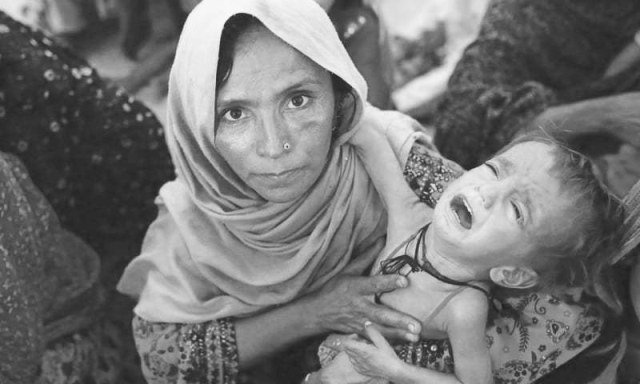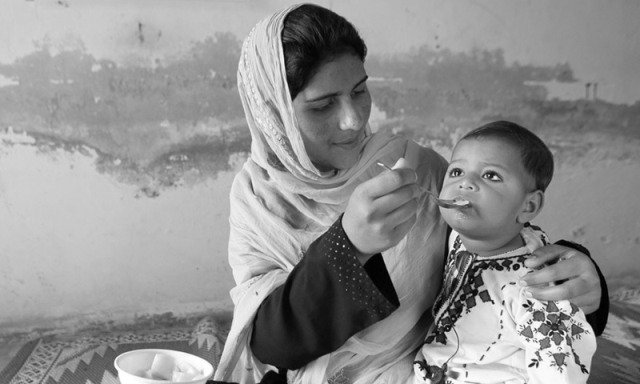National Family Health Survey (NFHS-5) has found that 89 per cent of children between the formative ages of 6-23 months do not receive a “minimum acceptable diet’’. This is only marginally better than the 90.4 per cent recorded in NFHS-4.
The NFHS report looked at adequate diet for both breastfeeding and non-breastfeeding children till they reached two years.
It found that 88.9 per cent of children between 6-23 months, who are breastfeeding, did not receive adequate diet in 2019-2020 — a slight improvement from 91.3 per cent in 2015-16. And that 87.3 per cent of non-breastfeeding children in this category did not receive adequate nutrition in 2019-21, up from 85.7 per cent in 2015-16.
Among all states and Union Territories, the proportion of children aged 6-23 months who received a minimum acceptable diet was highest in Meghalaya (28.5 per cent) and the lowest in UP and Gujarat (5.9 per cent each). In 2015-16, the proportion of children in this category stood at 5.2 per cent in Gujarat and 6.1 per cent in UP.
Apart from Gujarat and UP, 10 other states — Assam (7.2 per cent), Rajasthan (8.3 per cent), Maharashtra (8.9 per cent), Andhra Pradesh (9 per cent), MP (9 per cent), Telangana (9 per cent), Chhattisgarh (9.1 per cent), Jharkhand (10 per cent), Dadra & Nagar Haveli and Daman & Diu (10.2 per cent) and Bihar (10.8 per cent) — recorded a lower than national-level proportion (11 per cent) of children receiving adequate diet.
Among the top-five states where the percentage of children fom 6-23 months receiving adequate diet was highest, Meghalaya was followed by Sikkim (23.8 per cent), Kerala (23.3 per cent), Ladakh (23.1 per cent) and Puducherry (22.9 per cent).
“Infants and young children should be fed a minimum acceptable diet to ensure appropriate growth and development… Without adequate diversity and meal frequency, infants and young children are vulnerable to undernutrition, especially stunting and micronutrient deficiencies, and to increased morbidity and mortality,” the report said.
The NFHS found that access to minimum acceptable diet in this category of children is higher in urban areas (12.1 per cent) than rural areas (10.7 per cent).
Sixty-seven per cent of children age 6-59 months have anaemia, which is higher than the NFHS-4 estimate of 59 per cent. Thirty-six per cent of children under age five years are stunted (short for their age); 19 per cent are wasted (thin for their height); 32 per cent are underweight (thin for their age).

The WHO has defined ten essential food groups — cereals and millets, pulses, milk and milk products, roots and tubers, green leafy vegetables, other vegetables, fruits, fat or oil, fish, egg and other meats and sugar — out of which 4-5 every day are required for a child to prevent malnutrition.
Meanwhile, India’s total fertility rate (TFR) has declined from 2.2 in 2015-16 to 2.0 in 2019-21, indicating the significant progress of population control measures, revealed the report of the fifth round of the National Family Health Survey (NFHS-5).
The TFR is the average number of children born to a woman in her lifetime. The governments set targets for TFR for the purpose of population control. TFR of 2.1 is considered the replacement level fertility rate at which population stability is achieved.

According to the report, India has made significant progress in population control measures in recent times with the TFR, but there are wide inter-regional variations with five states still not having achieved a replacement level of fertility of 2.1. Bihar (2.98), Meghalaya (2.91), Uttar Pradesh (2.35), Jharkhand (2.26) and Manipur (2.17) are the five states, according to the NFHS-5 conducted from 2019-21.
The NFHS-5 survey was conducted in around 6.37 lakh sample households from 707 districts (as on March 2017) of the country from 28 states and 8 UTs, covering 7,24,115 women and 1,01,839 men to provide disaggregated estimates up to the district level.
In seven states, more than 90 per cent of the births in the last five years were institutional births. In Kerala, nearly 100 per cent of the births were institutional births. Only 46 per cent of the births in Nagaland were institutional births, according to PRS.
Institutional births increased by a maximum of 27 percentage points in Arunachal Pradesh, followed by over 10 percentage points in Assam, Bihar, Meghalaya, Chhattisgarh, Nagaland, Manipur, Uttar Pradesh, and West Bengal.
Stunting or chronic malnutrition (low height with respect to age) has increased in 11 of the 17 states. Children who are stunted or wasted are more vulnerable to diseases and illness.
As per the survey, stunting is higher among children in rural areas (37 per cent) than in urban areas (30 per cent) in 2019-21. Variation in stunting ranges from the lowest in Puducherry (20 per cent) and highest in Meghalaya (47 per cent).
A notable decrease in stunting was observed in Haryana, Uttarakhand, Rajasthan, Uttar Pradesh and Sikkim (7 percentage points each), Jharkhand, and Madhya Pradesh and Manipur (6 percentage points each), and Chandigarh and Bihar (5 percentage points each).
The report also found that the neonatal mortality rate declined from 49 deaths per 1,000 live births in the five years before the 1992-93 NFHS survey to 25 deaths per 1,000 live births in the five years before the 2019-21 NFHS survey.
The neonatal mortality rates in the five years before the 1998-99 survey, 2005-06 survey, and the 2015-16 survey were 43, 39, and 30 deaths per 1,000 live births, respectively.
The infant mortality rate declined from 79 deaths per 1,000 live births in the five years before the 1992-93 NFHS survey to 35 deaths per 1,000 live births in the five years before the 2019-21 NFHS survey.
During the same period, the under-five mortality rate declined from 109 deaths per 1,000 live births to 42 deaths per 1,000 live births.
Assam has seen one of the largest drops in the infant mortality rate, from 48 deaths (per 1,000 live births) to 32 deaths. The infant mortality rate remains high in Bihar (47 deaths per 1,000 live births).

